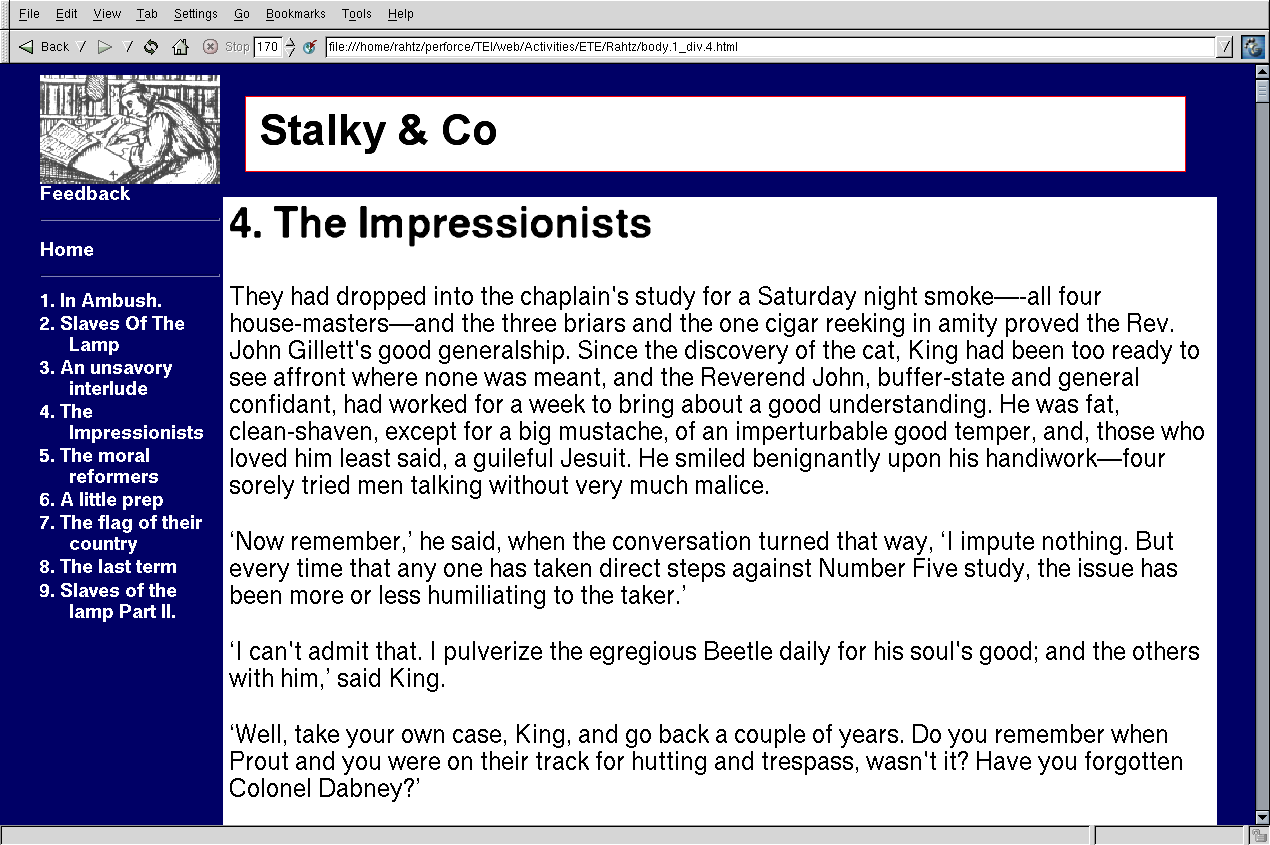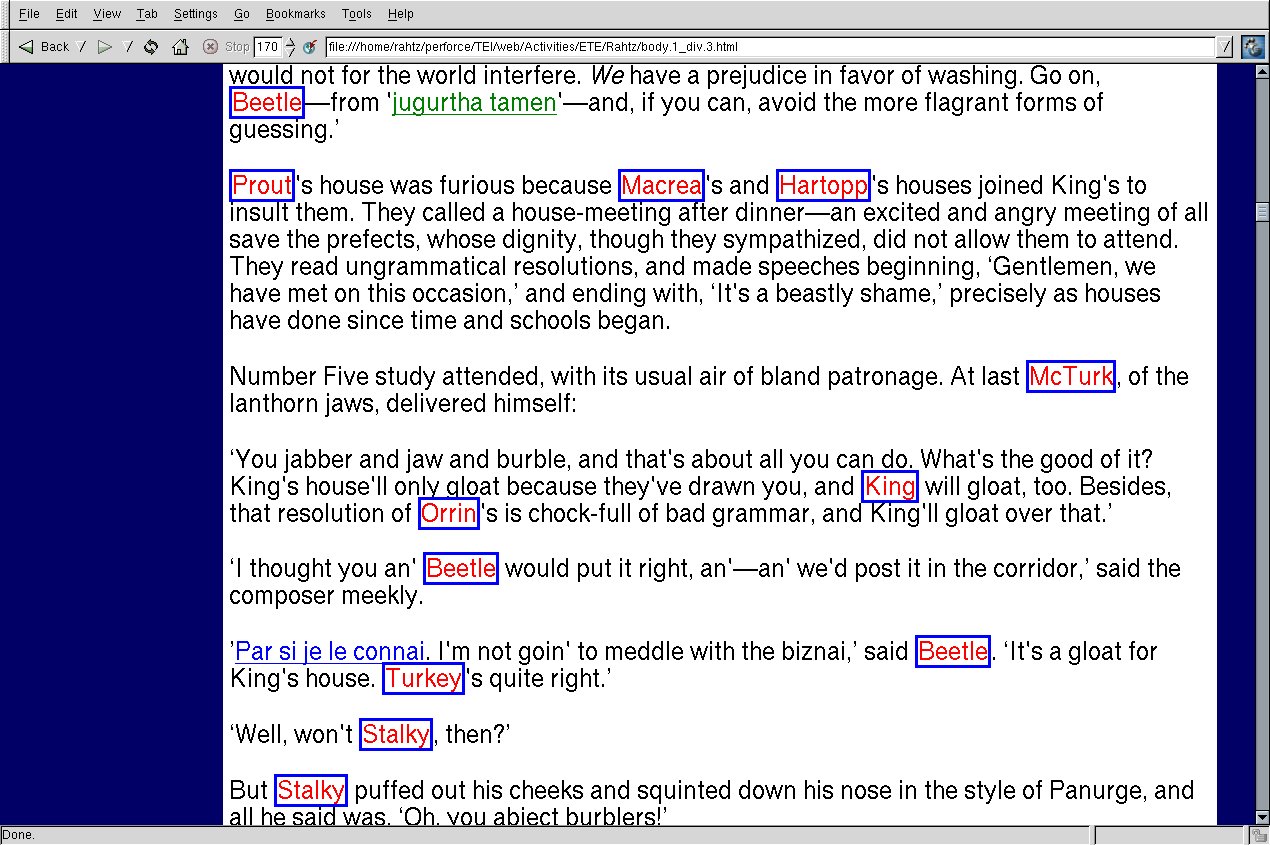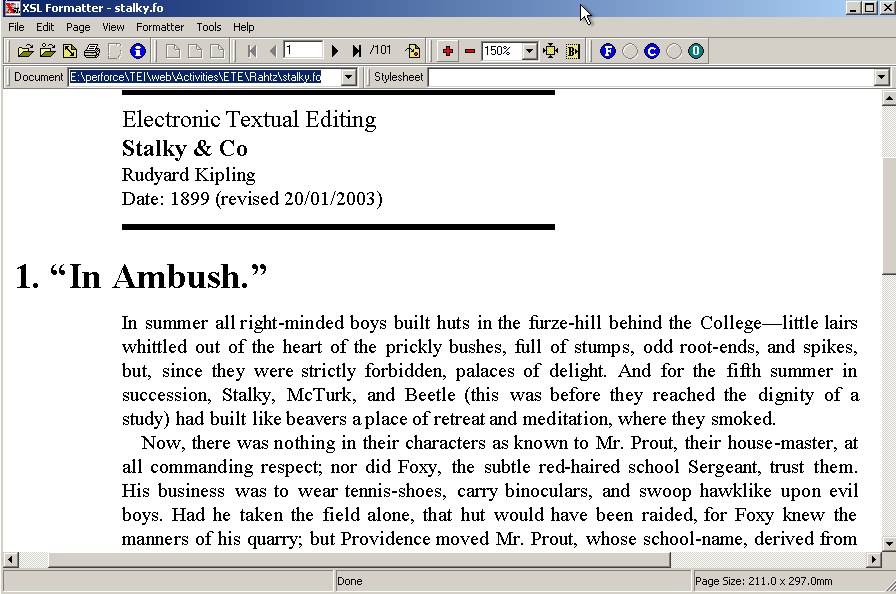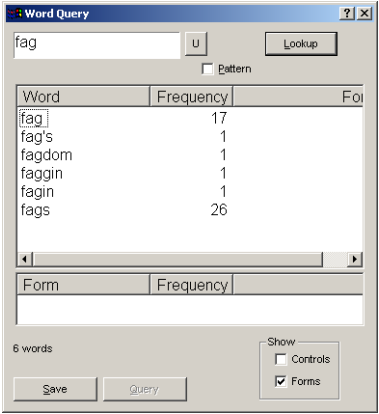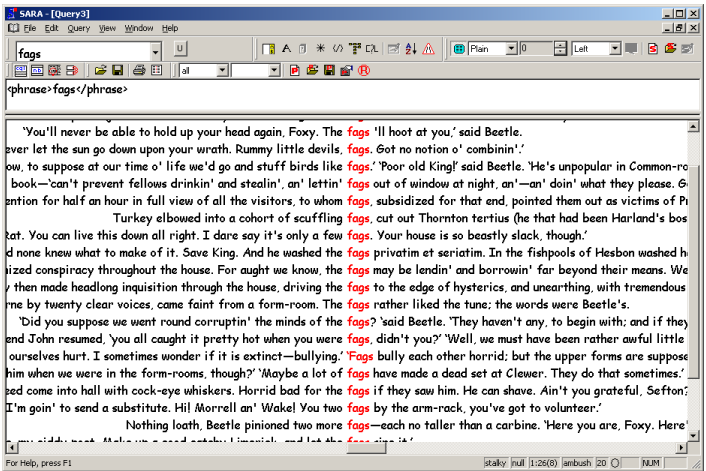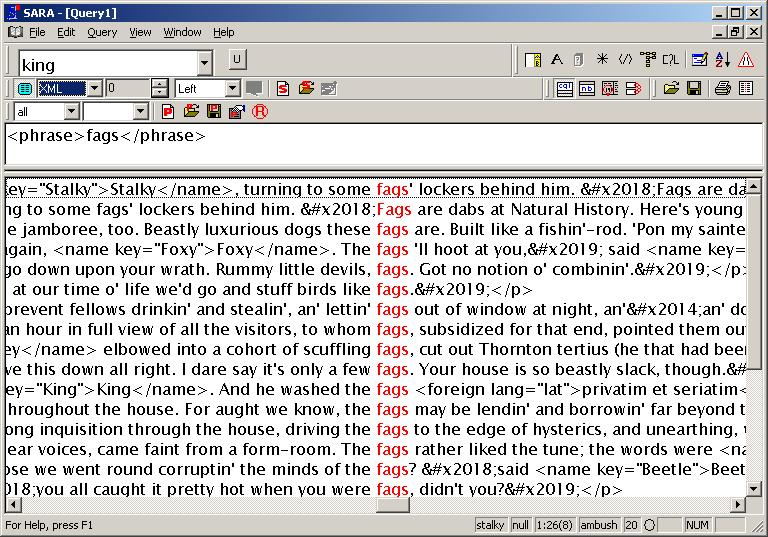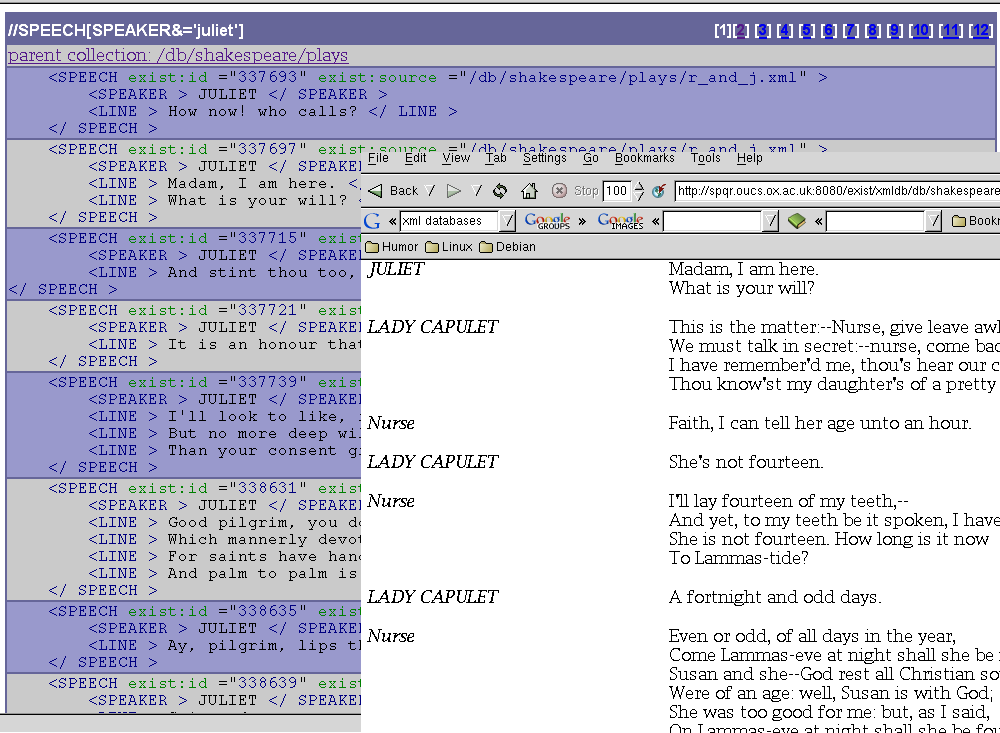Making a electronic text is sometimes regarded as an
end in itself. We spend much time making decisions on
what to encode, and
how to formalize it, and then invest huge effort in creating electronic
files representing our text. Publishing the result in some way was until recently
rather hard; the amount of information encoded in a full-scale TEI text is difficult
to represent in print, and we lacked easy systems to give readers access to the
work. The universality of the web changes everything; we now have a rich-featured
target environment in which to present text. However, print presentation remains
important, and we nearly always need to rearrange texts to publish them. In this
chapter, therefore, we look at:
-
transformations of encoded texts
-
converting TEI XML files for the web
-
preparing TEI XML files for print
-
database systems suitable for storing encoded
text
-
managing collections of text
In general, generic solutions using open standards are described, usually with
open source implementations.
Transformation
Those used to preparing texts in a word-processor
environment usually expect to see an approximation of the final result on their
screens as they write. Where they want to see an abstract, they write an
abstract, and where the bibliography is to appear, they start typing it in. The
fully-encoded TEI XML text differs from this scenario in three important
(related) ways:
-
The encoder often represents two or more
strands of information in a single text; marking up part of speech in a
text, while also representing the logical structure, and the physical
characteristics of a particular version, are reasonable things for a TEI
encoder to do.
-
The TEI offers more than one way to encode
information. Notes, for instance, may be embedded in the text, or placed
in a section or their own and pointed to from their insertion location.
The rendering sequence may not be related to the encoding sequence.
-
There is a distinct gap in many projects
between the encoding, and one or more representations, and the text is
better regarded as a database of information than a linear sequence.
There is no one output, and the desired results may change over time.
The effect of these differences is that rendering a TEI text very often
involves rearranging or transforming it in some way. This can involve:
-
Copying elements
-
Removing elements
-
Moving elements
-
Generating elements
In the following sections, we will look at examples of each of these in
turn and then consider what tools will do the work.
Copying elements
The most common reason for copying elements is
to create useful navigation systems like the table of contents. If the text
represents an existing book, with its own contents lists, then this will not
be needed, but in many circumstances we want to take a
summary of
the text and show it at the back or front. For example, if we take this
text:
1
<div> <head><q>In
Ambush</q></head> <p>In summer all right-minded boys
built huts in the furze-hill behind the College</p> </div>
<div> <head>Slaves of the Lamp Part I</head>
<p>The music-room on the top floor of Number Five was filled with
the ‘Aladdin’ company at rehearsal. </p> </div> <div>
<head>An Unsavoury Interlude</head> <p>It was a maiden
aunt of Stalky who sent him both books, with the inscription, ‘To
dearest Artie, on his sixteenth birthday’; </p> </div>
<head>The Impressionists</head> <p>They had dropped
into the Chaplain's study for a Saturday night smoke—all four
house-masters—and the three briars and the one cigar reeking in amity
proved the Rev. John Gillett's good generalship.</p>
it
would be reasonable to take each of the
<head>
elements and make a list at the front of the transformed text as a
list:
<list> <item><q>In
Ambush</q></item> <item>Slaves of the Lamp Part
I</item> <item>An Unsavoury Interlude</item>
<item>The Impressionists</item> </list>
The text
nodes of each
<head> element are copied to
the
<item> elements in the
<list> .
This example is trivial, but the application
is widespread. Texts for reading by humans very often contain duplicate
material (like many other books, every even-numbered page of Stalky &
Co repeats the title, to remind us of what we are reading). As usual
in TEI work, the extent to which the encoding captures the duplication
explicit in an original work very much depends on basic encoding decisions.
Some TEI texts may need no transformation by copying at all.
When considering the uses of copying, it is
important to remember that the <teiHeader>
section may contain material which is needed for rendering, and will be
copied into place. For instance, the human-readable version might be
annotated on each page with the date on which the text was encoded.
Removing elements
Most TEI texts contain elements which we do
not need to keep as-is when rendering the material. The obvious example is
the
<teiHeader> containing metadata, most of
which is not needed for typical rendering, but we may also choose:
-
not to show back matter or front
matter
-
to show only a sample of the text
divisions
-
to remove editorial notes
-
To suppress detailed metadata
resulting from linguistic analysis
-
To remove stage directions from a
play
-
To show only those portions of text
relating to a particular speaker or character
As a simple example, we might choose to
transform this:
<p>They had dropped into the
Chaplain's study for a Saturday night smoke—all four<note place='end'
type="editorial">King, Prout, White, Hartopp; but sometimes Macrea is
mentioned as a house-master as well. Is this reflecting the passage of
time?</note>house-masters—and the three briars<note place="end"
type="gloss">A briar is a type of pipe</note> and the one cigar
reeking in amity proved the <rs key="JG11" reg="Gillett, John"
type="person"> <name>Rev. John
Gillett</name></rs>'s good generalship.</p>
into
this
<p>They had dropped into the Chaplain's
study for a Saturday night smoke—all four house-masters—and the three
briars<note place="end" type="gloss">A briar is a type of
pipe</note> and the one cigar reeking in amity proved the Rev.
John Gillett's good generalship.</p>
by suppressing one type
of
<note> and removing the metadata about
the chaplain which might be used in other circumstances to
only
show paragraphs in which he is mentioned.
Moving elements
It may seem at first sight strange to propose
re-ordering our carefully-assembled text. But there are several occasions
when we may wish to do so. For example, a text which exists in several
versions may be encoded as set of separate <text>
elements, but for presentation purposes we want to show each
paragraph together with its variants; so the sequence of paragraphs A1, A2,
A3, A4, A5, B1, B2, B3, B4, B5 will become A1, B1, A2, B2, A3, B3, A4, B4,
A5, B5, as the two versions are interleaved.
Another situation when movement of elements
might be appropriate is when bibliographical citations are placed in their
own section in the
<back> element, but are
to be presented as footnotes. Thus the combination of
<xref type="cite" doc="BIB" from="id
(TEIP4)">(TEI, 2002)</xref>
and later
<bibl id="TEIP4">TEI <title
level="m">Guidelines for Electronic Text Encoding and Interchange
(TEI P4)</title>. Sperberg-McQueen, C.M., Lou Burnard, Steve
DeRose, and Syd Bauman, eds. Bergen, Charlottesville, Providence,
Oxford: Text Encoding Initiative Consortium,
<date>2002</date>.</bibl>
is turned into
(TEI,2002)<note><bibl id="TEIP4">TEI
<title level="m">Guidelines for Electronic Text Encoding and
Interchange (TEI P4)</title>. Sperberg-McQueen, C.M., Lou Burnard,
Steve DeRose, and Syd Bauman, eds. Bergen, Charlottesville, Providence,
Oxford: Text Encoding Initiative Consortium,
<date>2002</date>.</bibl></note>
by a
process of interleaving.
Naturally, any sorting of elements is a
process of moving, and any merging of material from a secondary file will
involve movement of material.
An extreme form of moving (and copying)
material is the rearrangement of a text into a concordance or wordlist.
Generating elements
We have already seen above some generation of
new elements; for instance, when we copied
<head>
elements to a series of list items, we had to create the surrounding
<list> . There is also a TEI element
<divGen> which explicit expects a
rendering application to do some work and create material. The action is
determined by the
type attribute, for which TEI P4 suggests
possible values:
- index
- an index is to be generated and inserted at this point.
- toc
- a table of contents
- figlist
- a list of figures
- tablist
- a list of tables
These actions again involve element copying of some kind; the ‘index’
value may involve working out index entries, for instance, from all the
<name> elements in a text.
A common form of generation is the addition of
automated linking, or the making explicit of implicit information. Thus the
text used above to identify a character:
<rs
key="JG11" reg="Gillett, John" type="person"> <name>Rev. John
Gillett</name></rs>
could be the key to generating a
link to the section of the document where Gillett is first mentioned, or to
detailed metadata about the person referred to, perhaps in a
bibliography.
The toolkit
Unless we want to simply turn a linear
sequence of TEI XML elements into exactly the same sequence of material
marked up in some other way, most real-life applications involve a
combination of all the techniques discussed above. It makes sense to
consider all these steps before we worry about how precisely we
want to publish the result; all of the examples above apply just as much to
print as to the web, and we can operate more efficiently if we
(conceptually, at least) perform all the transformations at the level of TEI
XML before converting to a particular result.
A wide range of software tools can do the
transformation for us. Any programming or scripting language which can
handle XML has the power to do almost all the tasks, but unless you are an
experienced programmer, it makes sense to stick to the Recommendations
defined by the World Wide Web Consortium. There are three useful ‘standards’
from the W3C which are relevant here:
- DOM
- A specification for how programming languages should provide access
to, and manipulate, the tree structure of an XML document
- XPath
- A specification for how to address parts of an XML document
- XSLT
- A high-level language for specifying transformations, using
XPath
For our purposes XSLT (well described in many reference and tutorial
texts, including Kay and Tennison as well as the extensive pointers at
http://www.xslt.com/
) fits the bill nicely. It is available in a number of efficient
implementations for most computer platforms and environments, including web
servers and clients, editors, as well as free-standing programs. The
commonly used implementations are MSXML, Saxon, Xalan, libxslt and
Sablotron; they are mostly open source and/or free. The language has some
interesting and important characteristics:
-
It is expressed in XML. You can write
scripts using your existing XML editor and use your existing
syntax-checking tools.
-
It is based on the use of a series of
templates, or rules, which specify what is to happen to particular
elements in from the incoming text; the processor works out how to
apply the rules.
-
Using the XPath language, any template
can access any part of the document at any time. You are not
constrained by a linear processing model.
-
XML namespaces are used to
differentiate the XSLT language itself from the output.
The result is that it is simple to implement all of the techniques we
have discussed.
It is beyond the scope of this chapter to
provide a detailed introduction to XSLT, but it should be helpful to see
some simple scripts.
Firstly, a script which takes each
<div> element and puts the corresponding
<head> element as an item in list:
<xsl:stylesheet
xmlns:xsl="http://www.w3.org/1999/XSL/Transform" version="1.0">
<xsl:template match="body"> <list> <xsl:for-each
select=".//div"> <item><xsl:apply-templates
select="head"/></item> </xsl:for-each> </list>
<xsl:apply-templates/> </xsl:template>
</xsl:stylesheet>
Note the
xsl: prefix for
statements which are part of the XSLT language; other elements, such as
<list> and
<item> are placed in the output. The fragment has a single
<xsl:template> , whose
select attribute identifies which input element (here,
<body> ) the rule applies to. The
.//div value for the
select attribute of
xsl:apply-templates is an expression in the XPath
language; it means ‘every div element you can find below here in the
document tree’. The final
<xsl:apply-templates>
tells the processor to carry on and process (again, in the case of
<div> s) all the elements inside the
current element (the
<body> ).
Secondly, a script fragment (we omit the
wrapper
<xsl:stylesheet> element from here
onwards) which
removes some elements:
<xsl:template match="note[@type='editorial']"/> <xsl:template
match="teiHeader"/>
By simply supplying no body for the
templates for
<teiHeader> , and
<note> elements with a
type
attribute of
editorial, the entire element and its contents are
passed-by.
Thirdly, to
move some elements, we
specify explicitly for an element (
<text> )
what to do; here, we say that we want the
<back>
,
<front> and
<body> elements to be processed in that order:
<xsl:template match="text">
<xsl:apply-templates select="back"/> <xsl:apply-templates
select="front"/> <xsl:apply-templates select="body"/>
</xsl:template>
Note that if we omit one of the
<xsl:apply-templates> lines, the corresponding
elements would never be processed.
Lastly, the
generation of elements.
Our example of copying elements already showed how to make a crude table of
contents; the following script appends a
<note>
element to each
<name> listing the
number of times that name occurs in the text:
<xsl:key name="NAMES" match="name" use="@key"/> <xsl:template
match="name"> <xsl:apply-templates/> <note>This name
occurs <xsl:value-of select="count(key('NAMES',@key))"/>
times</note> </xsl:template>
The
<xsl:key> element keeps a table in memory of all the
occurences of the
<name> element, indexed by
the value of the
key attribute; the
key
function retrieves a list from that table, and the
count
function counts them.
Making webs
If we have arrived at a transformation of a text
which has the correct components in the right sequence, we can start to render
it in a form suitable for human readers. The most common way to achieve this is
to convert it to HTML; thus the TEI markup
<div>
<head><q>In Ambush</q></head> <p>In summer all
right-minded boys built huts in the furze-hill behind the College</p>
</div>
might become
<h1>‘In
Ambush’</h1> <p>In summer all right-minded boys built huts in
the furze-hill behind the College</p>
This is, of course, no
different from the transformations we discussed in the last section; the
<head> element of the
<div> is used to construct the HTML
<h1> element, and the TEI
<p>
is turned into the similar HTML
<p> . Note also
the simplification of the
<q> element, which is
a replaced by a matching pair of single quotes.
This conversion to HTML involves no more nor less
than the transformation using copying, moving, removing and generating which we
described in the previous section, if we regard the HTML language as another XML
dialect. Luckily, all the XSLT implementations have a special output mode in
which they massage their output into HTML; if the transformation turns a TEI
<lb> into <br/>
(which it has to do, because the script must be well-formed XML), the
XSLT engine quietly makes that the standard HTML <br>
, to satisfy older Web browsers.
Although we describe it here as two stages,
transformation from TEI to TEI followed by transformation to HTML, most
applications do both at the same time, so
<xsl:template match="body"> <list> <xsl:for-each
select=".//div"> <item><xsl:apply-templates
select="head"/></item> </xsl:for-each> </list>
</xsl:template>
would be written in XSLT as
<xsl:template match="body"> <ol>
<xsl:for-each select=".//div"> <li><xsl:apply-templates
select="head"/></li> </xsl:for-each> </ol>
</xsl:template>
Writing a set of XSLT specifications for a markup
scheme as large as the TEI is not a trivial task to undertake. It is likely, for
instance, that you will want to create a
set of HTML files, rather than
just one, in which case you need to create lots of navigational links, and take
care of internal cross-references which go from one generated output file from
another. For example,
shows a
simple rendition of a TEI text, with a table of contents at the start and then
the sections following on, while
shows a delivery in which chapters are presented in individual documents
with a table of contents on the left.
Obviously there is an enormous number of other web display features which
can be driven by TEI markup or by editorial choice. Thus
shows a visual rendition of the
<name> element, from this XSLT:
<xsl:template match="name"> <span
class="name"><xsl:apply-templates/></span>
</xsl:template>
shows the
<foreign> elements with different colours according to the
type attribute, using this XSLT fragment:
<xsl:template match="foreign"> <span
class="foreign{@lang}"><xsl:apply-templates/></span>
</xsl:template>
in which a CSS
class attribute
is created using the word
foreign and the value of
lang. The key to these simple results, and very much more
complex ones, is deciding how HTML markup in the output can be created by
transforming input XML.
The TEI Consortium hosts a set of XSLT stylesheets
by Sebastian Rahtz on its web site at
http://www.tei-c.org/Stylesheets
which are designed for creating web pages. The results can be varied by
providing values for over 80 parameters, and by overriding individual
templates.
XSLT stylesheets for TEI documents can be applied
in a number of ways:
-
A reference to the stylesheet can be
embedded in the XML file using a processing instruction. Some web
browsers, including Internet Explorer and the Mozilla family, can then
view the XML file directly by transforming it to HTML dynamically. This
is a very easy and effective way to publish TEI XML documents, if you
can be sure the potential readers use the the right web client.
-
The web server can be set up to transform
the XML to HTML on request; the Cocoon and AxKit systems are examples of
this. They trap incoming requests for XML documents, perform the
transform, and return the HTML results. As the results are cached, this
can be very efficient, and has the advantage that it works with any
browser. The disadvantage is that the reader does not get access to the
original XML (this may also be seen as an advantage). Different
renditions can be made on the server by providing appropriate
instructions as part of the URL (ie a URL ending in
xyz.xml?style=print will be processing to pass the
parameter style with the value ‘print’ to the
stylesheet engine).
-
The XML can be transformed to HTML once at
source, and the result uploaded to a normal web server. This is the most
reliable, and causes the least load on the server, but it is also the
most cumbersome, as the text owner has to remember to remake the HTML
each time there is a change in the original. Any different renditions
also have to be precreated.
Preparing for print
It should be clear by now that the print version
of our texts follows much the same line as the web version. First, we define the
transformations needed to present the right bits of text in the right order, and
then we turn it into a print format. This is likely to be Portable Document
Format (PDF), created by a page makeup engine. The choice here is not as clear
as it is for the web, however. We may prefer any of:
-
A dedicated publishing system with its own
system of stylesheets and/or sophisticated interfaces for making up
pages; Quark Express and InDesign are good examples.
-
Commercial or free systems which can
create typeset pages from a semi-fixed page specification (XSL FO or
DSSSL)
-
Conversion to a well-understood non-XML
formatting language, such as LaTeX.
Which you use depends on whether you want to feed material to a
typesetting system where you can subsequently fine-tune and manipulate the
results, or whether you require automated page makeup with little need for
intervention.
If you plan to use a traditional
desktop-publishing system, one simple way to proceed is to turn your TEI file
into simple HTML and then read it into Microsoft Word or another similar
word-processor; many DTP programs can import such files.
shows our sample text imported into Word.
If this method is not suitable, the proprietary methods of the system
will have to be used. Some programs support XSLT as part of their process (eg
Arbortext Epic, or Advent 3B2).
The XSL Formatting Objects language (XSL FO for
short; see
(XSLFO), and many pointers to
software and tutorials at
http://www.w3.org/Style/XSL/
) is a W3C Recommendation which provides a good basis for automated page
makeup. It is a markup, expressed as XML, which describes a set of pages and the
characteristics of layout objects on those pages. The core principles of the
language design were
-
conceptual compatibility with DSSSL;
-
compatibility with CSS properties;
-
screen properties as well as print;
and
-
no compromises on internationalization (ie
many writing directions are supported)
When using FO, the input XML is transformed into
an output tree consisting of:
-
page masters, which define named styles of page layout;
and
-
page sequences, which reference a named page layout and
contain a flow of text. Within that
flow, text is assigned to one of five (rectangular)
regions (the page body, areas at the top, bottom,
left and right)
There is also allowance for floating objects (at the top of the page), and
footnotes (at the bottom), and the model covers writing in left to right, right
to left, top to bottom, and bottom to modes.
Within a region of text, we find one or more
-
blocks,
-
tables,
-
lists, and
-
floats
and within a block, we find
-
inline sequences,
-
characters,
-
links,
-
footnotes, and
-
graphics
All of these objects have a large number of properties, including
-
aural properties,
-
borders, spacing and padding,
-
breaking,
-
colors,
-
font properties (family, size, shape,
weight etc),
-
hyphenation,
-
positioning,
-
special table properties, and
-
special list properties
although supporting all of them is not mandatory for processors.
XSL FO does not specify where line- or page-breaks
are to occur, or precisely how to justify a paragraph, so the results from
different processors can vary. A sample of XSL FO markup is:
<fo:block font-size="10pt" text-indent="1em"
font-family="Times-Roman" space-before.optimum="0pt"
space-before.maximum="12pt">‘<fo:inline
font-style="italic">Ti-ra-ra-la-i-tu</fo:inline>! I gloat! Hear
me!’ Stalky, still on his heels, whirled like a dancing dervish
to the dining-hall.</fo:block>
in which a
<block> object is described, containing an embedded
<inline> object. The concept, and some of the
attribute names, will be to familiar to web developers from the CSS
language.
There are several good implementations of XSL FO,
both commercial and free (XEP, Antenna House XSL Formatter, FOP, and Arbortext
EPIC) most of which take an FO document and produce PDF pages some can generate
other formats, including PostScript, TIFF, and Windows GDI).
shows our sample text displayed in Acrobat after
conversion to XSL FO and then formatted to PDF using PassiveTeX;
shows the same FO file
formatted and displayed by the Antenna House formatter; the differences are
small, but instructive. Note that the line-endings are not the same, for
instance.
The chief disadvantage of the XSL FO approach is that it neither allows
direct manipulation or specification of the page, nor guarenteed page fidelity.
You cannot say ‘I always want this figure on page 54, half way down, with text
flowing around it, regardless of how much the text changes’, and neither can you
be
sure that your pages will have same breaks if you use two different
implementations. In practice, TEI documents tend to be neither designed for the
page, or require legal precision, so FO is a reasonable choice.
XSL FO is generally created by a transformation
from higher-level XML; it is highly verbose and hard to write by hand. XSLT is
again a good tool to perform this transformation, as the task is very similar to
the creation of HTML. The TEI Consortium again hosts a set of parameterized XSLT
stylesheets by Sebastian Rahtz on its web site at
http://www.tei-c.org/Stylesheets
which can be used to create XSL FO from TEI XML. These allow for obvious
layout changes including
-
change of page-size and basic
font-size;
-
size and style of headings;
-
whether or not headings are numbered;
-
single or double column;
-
management of cross-references.
Orthogonal to the methodology adopted (automated
or interventionist) is the method of software integration. Some systems offer
closely integrated publishing solutons (eg Arbortext's Epic,
http://www.arbortext.com/html/products.html
), which cover all aspects of the document management process, including
editing, stylesheets, print publication, web publication, database integration
etc. The alternative is a set of loosely-related solutions for each situation
along the line, perhaps drawn from both commercial and open-source software.
Both approaches are equally valid, and generally speaking the TEI encoder can be
slightly relaxed, since the overwhelming effort is in creating the neutral XML
source in the first place.
Database systems for TEI and XML
Our discussion so far has been on the level of
simple XML files, and manipulating them individually. What if we want to present
composite results from a whole collection of TEI texts? On a small scale, this
can be done with XSLT, since that language allows for reading multiple input
files, selecting arbitrary subsets, and making a composite output. However, all
current XSLT implementations work in memory, and read the documents afresh each
time a script is run. This makes the technique unsuitable for documents over a
certain size, or when many queries need to be run at the same time; in that
situation we need to turn to a dedicated database.
Database systems have two important
characteristics for our purposes; firstly they do not store all the data in
memory, and are designed to cope with arbitrarily large collections, with
equally efficient acecss to any part; secondly, they support multiple
simultaneous queries. How do they work in the XML context? Ronald Bourret (at
http://www.rpbourret.com/xml/XMLAndDatabases.htm
) has an exhaustive discussion of the details; here we summarize four simple
ways to proceeed:
-
We can store entire XML documents as
single text objects in a conventional database, and query it using
substring operators. This works well if we always want entire documents
back, but it becomes clumsy if we want to pick out small subsets. For
example, we might want all the speeches by Horatio in the play
Hamlet
-
The XML file can be decomposed into
separate elements, and each one stored as a separate row in a relational
database. This is rather complex to achieve, but works quite well for
some sorts of query. The problem is the overhead of reconstructing
complex XML structures again (the text of Hamlet would be
thousands of rows, off of which may have be carefully stitched together
again.)
-
If the XML files are complex and static (a
large linguistic corpus, perhaps) a fixed index to all the elements can
be created. This allows for fast querying of certain types, and can be
very efficient.
-
A dedicated XML database can be used.
Typically, these are queried using the XPath language we saw in relation
to XSLT. The big advantage is that there is no difference between
retrieving the entire text of Hamlet and just a few lines from
all Shakespeare plays, using a consistent query language. The problem is
that XML databases are far less mature than big relational databases,
and present problems when it comes to updating portions of the
tree.
TEI documents are likely to be fairly static, but
with complex nested structures, so the second two choices above are the best to
consider.
Xaira is an example of an XML database which works
by pre-processing the input and building indices. It provides an analytical view
of a text, mainly for those interested in linguistic analysis, but it returns
XML fragments which are styled under control of the user.
shows a session with Xaira, selecting words
which will be treated as variants of
fag.
shows a concordance of
fag, while
shows the same concordance, but with XML markup visible.
eXist (the Apache Project's XIndice offers similar
features) is an example of a dedicated XML database engine. It has no interface
of its own, but can talk to other programs or services using HTTP, XML-RPC, SOAP
and WebDAV. This makes it easy to deploy inside dynamic web page systems, such
Apache's Cocoon. The only job of the database is to return a well-formed XML
tree which other applications can process. It is queried using XQuery or XPath
expressions, with support for some small extensions to permit more reasonable
substring searches within element content. Examples of XPath queries follow,
where the root is expressed with
document and
collection functions to identify a single document or
named group of documents:
-
document('test.xml')//div
- All <div> elements in document test.xml
collection('xx')//div All <div> elements
in all documents in the demo collection
-
collection('xx')//div[.//p[contains(.,'Hello')]]
- All <div> elements which contain <p> elements containing the phrase
'Hello'
-
collection('xx')//div[.//xref[@url='www.lexmark.co.uk']]
- a <div> with an
<xref> with a url attribute pointing
to Lexmark
-
collection('xx')//list[count(item)>9]
- Lists with more than 3 items
-
collection('xx')//div[starts-with(head,'Introduction')]
-
<div> elements with a title starting
Introduction
-
collection('xx')//q[string-length(.)>100]
- quotations longer than 100 characters
-
collection('xx')//person[.//surname[.='Keats' or
.='Shelley']]
-
<person> elements for Keats or Shelley
All these queries use standard syntax. eXist also supports some extra
functions and operators, which is uses to give efficient access to a full-text
index which it maintains in addition to the structural database:
-
collection('xx')//p[match(.,'[A-Z]IED\b')]
- paragraphs with words ending in 'IED'
-
collection('cem')//ab[near(.,'BOY YEARS',4)]
-
<ab> elements with the words BOY and
YEARS in a proximity of four words
-
collection('cem')//ab[.&='BORN IN ROME']
-
<ab> elements with the phrase 'BORN IN
ROME'
-
collection('cem')//ab[.|='GOD LOVE']
-
<ab> elements with the words 'GOD' or
'LOVE'
While these extensions are not necessary for most applications, they are
likely to be relevant to TEI users.
We can see how eXist presents its results by
looking at what comes back from the query against
Stalky & Co: of
//foreign[@lang='fr']
ie all the words
marked as
<foreign> with the value
fr
for the
lang attribute:
<?xml
version="1.0" encoding="utf-8"?> <exist:result
xmlns:exist="http://exist.sourceforge.net/NS/exist" hitCount="19"
queryTime="41"> <foreign lang="fr" exist:id="12751728"
exist:source="/db/kipling/stalky.xml"> aujourd'hui</foreign>
<foreign lang="fr" exist:id="12751730"
exist:source="/db/kipling/stalky.xml"> Parceque je</foreign>
<foreign lang="fr" exist:id="12752720"
exist:source="/db/kipling/stalky.xml"> langue de guerre</foreign>
<foreign lang="fr" exist:id="12793848"
exist:source="/db/kipling/stalky.xml"> Twiggez-vous</foreign>
<foreign lang="fr" exist:id="12793938"
exist:source="/db/kipling/stalky.xml"> Nous twiggons</foreign>
<foreign lang="fr" exist:id="12799254"
exist:source="/db/kipling/stalky.xml"> a la</foreign> <foreign
lang="fr" exist:id="12804738" exist:source="/db/kipling/stalky.xml">
Moi</foreign> <foreign lang="fr" exist:id="12804740"
exist:source="/db/kipling/stalky.xml"> Je</foreign> <foreign
lang="fr" exist:id="12847398" exist:source="/db/kipling/stalky.xml"> Par
si je le connai</foreign> <foreign lang="fr" exist:id="12866298"
exist:source="/db/kipling/stalky.xml"> Je vais gloater</foreign>
</exist:result>
in which each result fragment is given extra
attributes in the eXist namespace identifying the source document and an
internal identifier. These could be easily transformed using an XSLT stylesheet
to present them in any desired way.
shows two aspects of a web interface to Shakespeare plays using eXist; the
lower view shows the XML results of searching for speeches by Juliet; the upper
view shows a complete retrieval of
Romeo and Juliet formatted using XSLT.
Most XML databases suffer from the problem of
effective update of documents; adding in elements to a complex tree
structure requires careful checking of constraints, and rebuilding of indices.
The XUpdate proposal attempts to specify standard ways of managing this. Another
problem are the extensions to XPath needed for fully effective database
searching; this is covered by the W3C XQuery and this is not yet fully accepted
or dominant. It remains sensible to use text files as archival storage, and use
the XML databases for static presentation.
Conclusions
The publisher of a TEI XML document has a wide
variety of methods to access the data locked within. While any XML-aware
software can do the job, we are also able to take advantage of a wide range of
open standards, with commercial and open source implementations. For
transformation, typesetting, retrieval, and analysis, it is increasingly easy to
use off-the-shelf packages.

